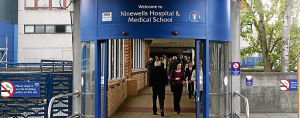Homerton University Hospital NHS Foundation Trust
Streamlining Medical Equipment Management
Challenge:
Managing medical equipment efficiently across a large Trust
Based in the London Borough of Hackney, Homerton University Hospital provides general health services across the community with staff working out of 75 different sites. The hospital has over 500 beds spread across 11 wards, a nine bed intensive care unit, as well as maternity, paediatric and neonatal wards. The Trust employs over 3,500 staff and is recognised as an innovator in embracing methods and systems that promise better and safer patient care.
Lack of visibility of equipment location – the location of medical equipment owned by the Trust was not being captured and recorded on a frequent basis. This became even more problematic when equipment was moving round the hospital.
Lack of audit capability – the tools that were available to undertake equipment audits were limited. As a result, information was lacking about device availability and the proportion that were lost, stolen or had been transferred to other locations outside the hospital.
Significant time wasted – the team at Homerton University Hospital were wasting a lot of time looking for equipment. According to the Nursing Times, more than a third of nurses waste up to two hours a shift searching for missing medical equipment.
Poor equipment utilisation rates and substantial re-procurement costs – the Trust invests a significant amount of money annually on procuring medical equipment to replace ‘lost’ devices. Generally, these devices are not lost but stored within the hospital in a place that only limited employees have access to.
The staff love iFIT. It cuts down wasted time. We have a working system and the future roadmap looks really good!
Brian Long
Head of Medical Electronics,
Homerton University Hospital
Solution:
Driving change with iFIT
Idox’s hospital inventory and records management solution, iFIT is providing users at Homerton University Hospital with the ability to manage and utilise medical equipment far more efficiently. Not only does the solution use tag agnostic technology for effective tracking, but also in the future it will manage the assignment of assets to patients, along with their decontamination and maintenance scheduling. This captures the who, what, where, when and why of data that is required to support the Scan4Safety mandate, ensuring patient safety and granting the Trust the ability to future plan and assess asset utilisation.
The team is now equipped with handheld mobile devices to manage the complete lifecycle of equipment. By scanning asset tags, staff are provided with the full status of the asset, including its location and usage history as well as the upcoming schedule. This data is also being used by other business functions, such as procurement, to determine what new equipment is required and where in the hospital it is needed the most.
Outcome:
Delivering efficiencies and financial savings
“iFIT has been instrumental in turning around our medical equipment management,” says Brian Long, Head of Medical Electronics at Homerton University Hospital. “We can now locate our equipment easily and quickly. In the past, if an item was moved out of the library or between departments in the middle of the night we wouldn’t know where to find it in the morning.” In addition, all loan equipment is now tagged upon arrival to the hospital. This ensures that the team can return it back to the supplier at the end of the term, hence avoiding unexpected penalty fees.
Improving equipment utilisation with iFIT has considerably reduced expenditure at Homerton University Hospital. Brian gives an example: “We have been able to reduce the size of the equipment library. After implementation and when items were no longer going missing, we discovered that we were overstocked. We have been able to reduce our inventory procurement level by 25%.”
Furthermore, the team can now locate equipment scheduled for maintenance swiftly – wherever it is in the hospital. Following implementation, planned preventative maintenance rates increased from 80% to 95% overnight, significantly reducing patient risk. With iFIT, the trust could also cancel an £80K annual maintenance agreement since it was noted that the equipment covered was no longer in service.
With iFIT, ward audits have become a simple task and are carried out daily. With one scan in each different area, we scan every item in the library, so we immediately know which equipment was moved overnight. Brian adds: “In the past, it would sometimes take a skilled technician all day to find a certain device. This was not only time consuming but also very demoralising; foraging for equipment rather than using their skills to operate them. Now, the time we spend looking for equipment has been reduced from days to seconds.”
The Trust is using the iAssets solution, part of the iFIT tracking and hospital management platform.






